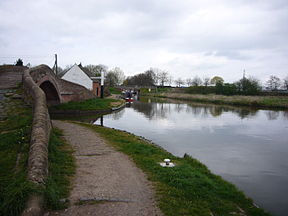Great Haywood Junction
Haywood Junction (grid reference SJ994229), or Great Haywood Junction, is the name of the canal junction where the Staffordshire and Worcestershire Canal terminates and meets the Trent and Mersey Canal near to the village of Great Haywood, Staffordshire, England.
The Trent and Mersey Canal was conceived as a way to provide a link between Liverpool and Hull, passing through the Potteries. It was authorised by an Act of Parliament in 1766, and with James Brindley acting as engineer, its 93 miles (150 km) were completed eleven years later in 1777.
Brindley also built the Staffordshire and Worcestershire Canal, which was begun at much the same time as the Trent and Mersey, and was completed in 1772. It joined the Trent and Mersey Canal at Great Haywood, and was part of his Grand Cross plan to link four English estuaries: the Humber, Thames, Severn and Mersey. Haywood Junction therefore became a major transport interchange.
At Great Haywood, the Trent and Mersey Canal heads north, as it continues its ascent from Derwent Mouth towards its short summit near Stoke on Trent. Haywood Lock is just to the south, while Hoo Mill Lock is a little further to the north. The River Trent runs to the west of the canal, much too small at this point to support navigation. Derwent Mouth, where the canal joins the river, is 39 miles (63 km) from the junction, while Etruria Lock, where the summit level begins, is 18.9 miles (30.4 km) away.
...
Wikipedia

